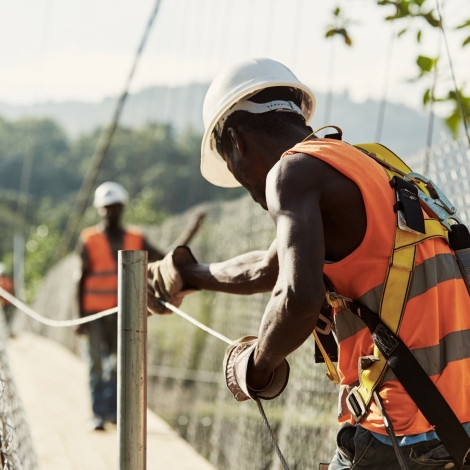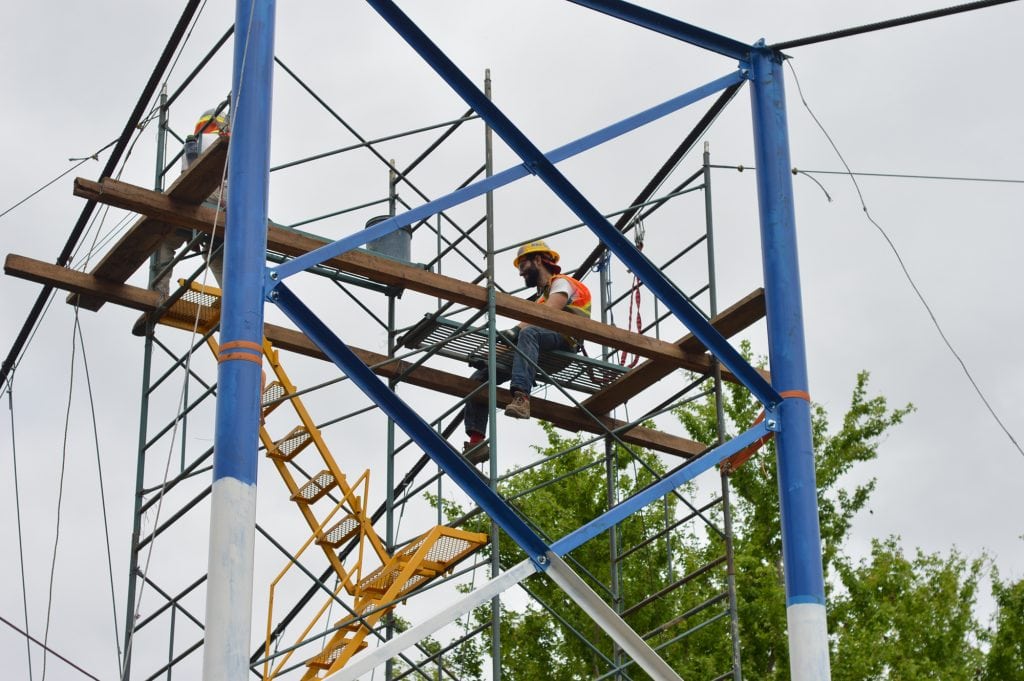Bridges provide connections for communities to access the services they need safely and conveniently. Unfortunately, in developing countries, bridges and other infrastructure are often in poor condition or nonexistent.
The creation of new bridge crossings could connect the world’s rural and underserved communities in developing countries with services they need. Those may include safe access to schools, healthcare and new employment opportunities.
“On a household level, the effect of a bridge is considerable. On a community level, it is enormous.”
One organization at the forefront of building new bridges in developing communities is Bridges to Prosperity (B2P).
“On a household level, the effect of a bridge is considerable,” says Alissa Smith, Director of Engagement for B2P. “On a community level, it is enormous.”
That statement has a basis in scientific research. In 2013, Bridges to Prosperity and economists at the University of Notre Dame partnered to examine the potential of footbridges to create economic returns. Their three-year randomized, controlled trial in rural Nicaragua found that a footbridge resulted in a 30 percent increase in household income and a 56 percent increase in agricultural yields of staple corn crops. The study also found that bridges increased investments back into the community, represented by a 69 percent increase in spending on agricultural goods like fertilizers and pesticides.
A bridge also appeared to decrease the perception of risk. The likelihood of a household experiencing involuntary rationing of food staples during floods in communities without a bridge reaches nearly 50 percent, but drops to just 2 percent in communities with a bridge.
This kind of data gathering is not new to B2P.
“Bridges to Prosperity has invested over the last two years in key systems that will allow us to better serve isolated communities,” Ms. Smith says. “These systems utilize technology and newly developed software to create a comprehensive database that links project management, volunteer and donor information, in-field assessment, and evaluation data collection so that B2P’s staff can more efficiently diagnose and address challenges, identify trends in engagement or impact, and communicate across departments, program countries, and end-user communities.”
Smith says the organization has worked with Salesforce developer Tact to integrate these systems and launch mobile data collection devices and an SMS survey program, which will be rolled out in all B2P program countries by 2019.
Let’s take a closer look at some of the key benefits of engineering bridges in developing communities.
Safe Passage
Rural communities surrounded by water bodies are required to find alternate methods across if no bridges exist. Spring snow melts and heavy rains can create such dangerous conditions people can’t cross safely.
Lack of access to bridges means residents are either stranded without access to necessary resources or faced with the risk of a potentially life-threatening crossing. Structurally sound bridges provide developing communities with a safe and direct access point throughout the year.
Educational Opportunities
Nearly 121 million adolescents and children worldwide are out of school, with a disproportionately large percentage living in developing countries. Seasonal flooding and changes in rivers and streams can block access to schools for children living in rural communities without a bridge. Bridges provide the secure access needed to prevent accidental drowning or injuries.
“Qualitatively, we know that the rainy season, and the periods of flooding that accompany it, align with times of low school attendance and student tardiness for communities where children are cut off from the school building by a dangerous river,” Ms. Smith says. “In these communities, we’ve seen the number of days in school increase, tardiness decrease, and academic performance improve after a footbridge is constructed.”
The same goes for employment outside of the community.
“When residents are able to consistently and reliably reach jobs outside of the community, you begin to see increases in labor market income, and a decrease in subsistence farming, indicating that community members have more choice in how they earn a living, and within that choice, experience improved livelihoods for themselves and their families,” Ms. Smith says.
Economic Opportunities
Tallying the benefits, Bridges to Prosperity calculates that the annual return on investment for a footbridge in rural Nicaragua is USD $10,000. That is “perhaps the most commanding argument for economic impact at the community level,” Ms. Smith says.
That figure incorporates direct and in-kind project contributions from Bridges to Prosperity, local governments, and communities, and effects on household income experienced by communities with new footbridges.
“This means that, strictly from an economic perspective, the bridge fully pays back initial investment in seven years. B2P’s bridges are designed for a useful life of 30-plus years. You can see the tremendous value created by the seemingly simple intervention of a pedestrian bridge,” Ms. Smith says.
Bridge construction has the potential to generate new economic opportunities for communities by providing faster, more reliable transportation routes to neighboring villages and cities.
Residents of rural communities would then have access to more employment opportunities due to the reduced transportation time. This could lower the global rural poverty rate, which is currently at 63 percent.
Almost 767 million people in the world live in extreme poverty. Investment in new bridges may be a means of reducing this figure. Construction could create new job opportunities for community members.
In addition to benefiting our already overtaxed planet, sustainably constructed infrastructure is also good for economic development because it helps drive local job creation while saving money.
Another benefit of adding new bridges to rural areas is reduced product costs. Goods in local markets may have lower prices due to decreased transportation costs. Community members would be able to afford more of their necessities or have money to set aside for savings.
Agriculture
More than 1 billion people in the world work in agriculture, which equates to one in every three workers. Farmers without readily accessible transportation routes are are cut off from potential customers. Community members in developing areas don’t have as much access to the food storage options available in more developed areas, due to a lack of reliable electricity and the high cost of appliances. Without these storage options, food goes to waste before it is sold.
Farmers who are unable to sell their products quickly are also at risk of losing crops to pests. Lower-income communities don’t always have access to the resources to prevent animals and insects from impacting their harvest. The quicker farmers can distribute their harvest, the lower the risk of losing it.
Drinking Water Access
Across the globe, 849 million people don’t have access to safe drinking water. Nearly 159 million of these people depend on surface water. Bridges in these communities have the potential to help residents access safer water sources by enabling them to commute further and more quickly.
Bridge construction can improve the local economy and quality of life in developing and rural communities throughout the world by providing a safer and quicker means of transportation. Engineering new bridges in developing countries can have a dramatic impact on those living there. The benefits of such projects aren’t going unnoticed.
“We continue to explore, through our new Lean Data Program which utilizes SMS surveys to assess the impact of a footbridge on individual end-users, the influence of footbridges on access to schools, health clinics and hospitals, and employment,” Ms. Smith says.



Really very usefull for me like practing engineer..